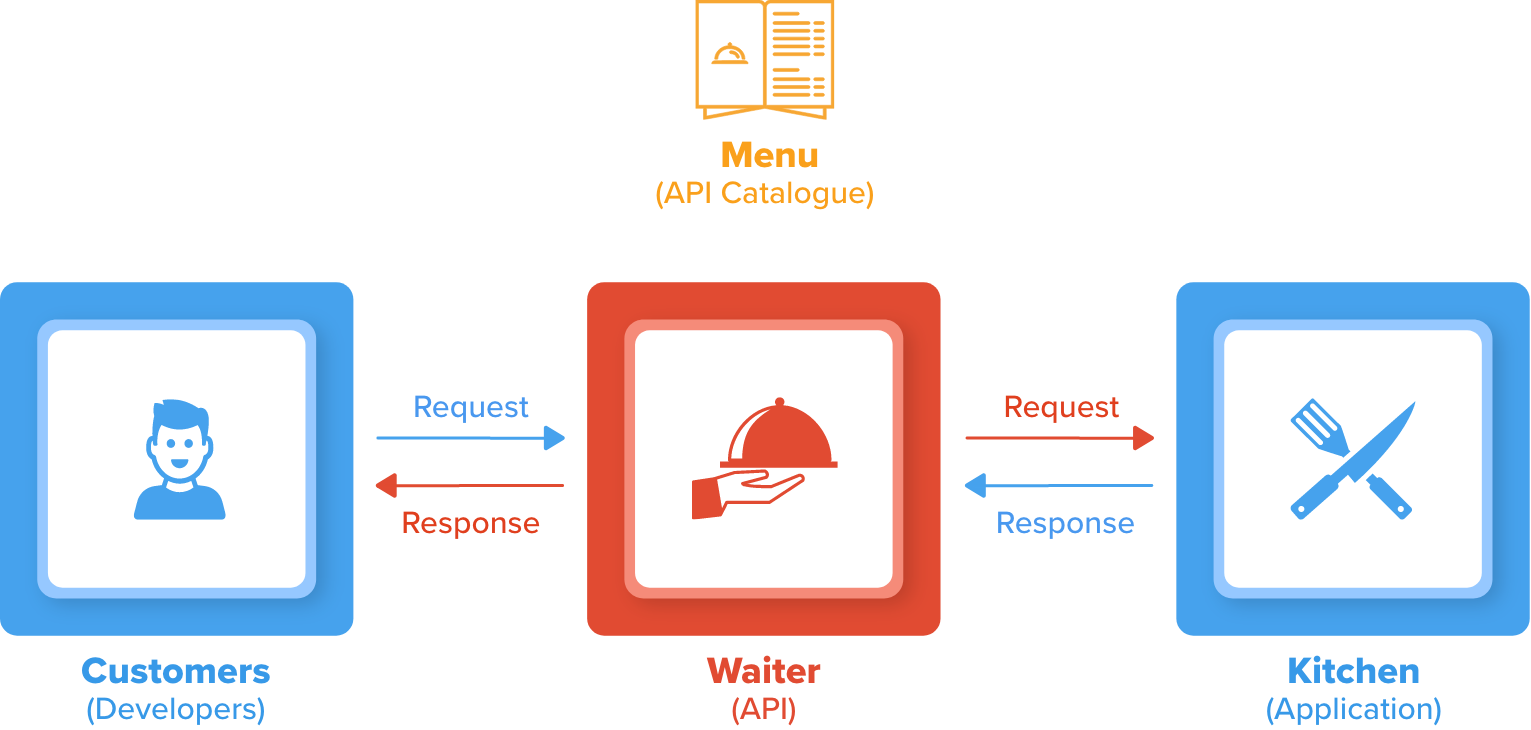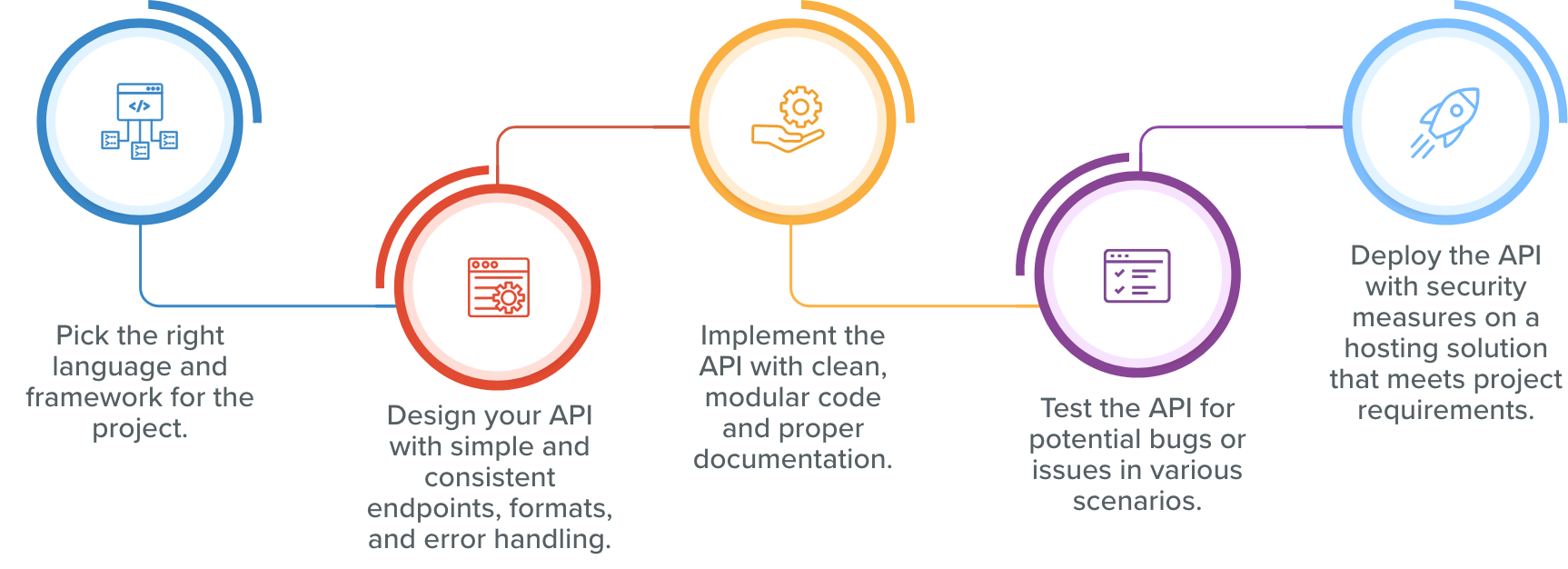Are you familiar with the term "API" but not entirely sure what it means? Don't worry, you're not alone! In a nutshell, an API (or Application Programming Interface) is like a waiter in a fancy restaurant. Just as a waiter takes orders from customers and communicates them to the kitchen, an API allows different applications to communicate with each other and exchange information.

APIs have become an essential component of modern technology, allowing different software programs to work together seamlessly. Without APIs, your favorite apps like Instagram, Uber, and Spotify would not be able to function as they do.
Did you know that the concept of APIs has been around since the early days of computing? However, with the rise of the internet and cloud computing, APIs have become even more prevalent and powerful. Today, there are countless types of APIs available, from REST to SOAP to GraphQL, each with its unique features and use cases.
In this blog, we'll explore everything you need to know about APIs, from their basic definition and purpose to how to create and use them in your projects. So, let's get started and uncover the fascinating world of APIs.
Definition of API and its purpose:
An API, or Application Programming Interface, is a set of rules and protocols that allow different software applications to communicate with each other.
In other words, think of it like a menu at a restaurant - it lists the available options (functions or operations) that an application can request from another application.
Types of APIs:
- REST (Representational State Transfer): It's a popular architectural style used for designing networked applications, commonly used for web services. It relies on standard HTTP methods like GET, POST, PUT, and DELETE for communication.
- SOAP (Simple Object Access Protocol): It's a protocol that uses XML for exchanging structured information. It's often used in enterprise-level applications for its robustness and security features.
- GraphQL: It's a newer API technology that allows clients to request only the data they need and is gaining popularity for its flexibility and efficiency.
API Protocols:
- HTTP (Hypertext Transfer Protocol): It's the foundation of the World Wide Web and is the most common protocol used for APIs. It uses a client-server model, where clients (such as web browsers or mobile apps) send requests to servers, and servers respond with data.
- HTTPS (HTTP Secure): It's a secure version of HTTP that encrypts data to ensure confidentiality and integrity during communication.
- TCP (Transmission Control Protocol) and UDP (User Datagram Protocol): These are transport layer protocols used for transferring data between applications over a network. TCP provides reliable, connection-oriented communication, while UDP offers faster, connectionless communication.
API Requests and Responses:
- API requests are made by clients to request specific actions or data from a server. Requests typically include the URL (Uniform Resource Locator) of the API endpoint, along with any parameters or data required.
- API responses are the server's replies to the requests, containing the requested data or indicating the success or failure of the request. Responses are usually in a structured format like JSON or XML.
API Endpoints:
- API endpoints are specific URLs that represent different functions or resources of an API. For example, /users might represent a collection of user data, while /users/123 could represent a specific user with the ID 123.
- Endpoints define the actions that can be performed on the API, such as retrieving data, creating new data, updating existing data, or deleting data.
Understanding these key concepts of APIs is crucial to grasp the foundation of how APIs work and how different types of APIs and protocols function. So, let's move on to the next part to learn how to create your own API.
Creating an API
Creating your own API can seem like a daunting task, but by following the below easy steps you'll be able to create your own API in no time.

- Choose the right programming language and framework: Just like picking the perfect ingredients for a recipe, choosing the right programming language and framework is crucial for creating a robust API. Consider factors such as your project requirements, team expertise, and community support before making a decision.
- Design your API: Think of your API as a user interface for developers. Designing a clear and intuitive API is essential for its adoption and success. Define the endpoints, request, and response formats, authentication mechanisms, error handling, and any other relevant details. Keep it simple and consistent.
- Implement your API: Once you have your design in place, it's time to start coding. Use your chosen programming language and framework to implement the API based on the design specifications. Follow best practices, such as using proper naming conventions, writing clean and modular code, and documenting your code for future reference.
- Test your API: Just like taste-testing a dish, it's crucial to thoroughly test your API to ensure it's working as expected. Use tools like Postman or Curl to make API requests and verify the responses. Test for different scenarios, including edge cases, to catch any potential bugs or issues.
- Deploy your API: Congratulations, your API is ready to see the world. Choose a hosting solution that aligns with your project's requirements, such as a cloud-based server or a dedicated server. Set up proper security measures, such as HTTPS and authentication, to protect your API from unauthorized access.
Remember, creating an API is an iterative process, and continuous improvement is key. Keep refining and optimizing your API based on feedback and changing requirements to ensure its reliability and scalability.
Using APIs
So, Now as we understand APIs and their types, Let’s find out how can you use them in your own projects. Here are some pointers to get you started:
- Examples of popular APIs: Some of the most well-known and widely-used APIs include Google Maps, Twitter, Facebook, and Amazon Web Services. These APIs provide developers with access to a wealth of data and functionality, from mapping and social media to cloud storage and web services.
- How to use APIs in your own projects: To use an API in your project, you need to first understand its documentation and how to make requests to its endpoints. APIs usually require authentication or authorization, which means you need to have the right credentials to access them. Once you have these credentials, you can use various programming languages to make API requests and retrieve data.
- API documentation and reference guides: Good API documentation is essential for developers to understand how to use an API. Documentation typically includes instructions on how to authenticate, how to make requests, and what data is available. Additionally, most APIs provide reference guides that list all available endpoints and their corresponding parameters.
- API best practices and common pitfalls to avoid: While using APIs can be powerful, there are some common pitfalls to avoid. These include overusing an API, not understanding rate limits, failing to handle errors gracefully, and not properly securing API credentials. It's important to follow API best practices and guidelines to avoid these mistakes.
- Securing APIs: Securing APIs is crucial to protect against unauthorized access and data breaches. Best practices include using secure communication protocols like HTTPS, implementing strong authentication and authorization methods, and monitoring API activity for suspicious behavior.
In summary, using APIs can be a game-changer for developers looking to add functionality and data to their applications. Understanding how to use APIs and following best practices can help you create powerful and secure applications that leverage the power of APIs.
Advanced API Topics
Now that we've got the basics down, let's dive into some advanced API topics that can level up your API game:
- API versioning: APIs can evolve and change over time, and it's important to manage these changes to avoid breaking existing applications. API versioning allows you to make updates to your API while maintaining backward compatibility with older versions. This ensures that your API consumers can continue to use your API without disruptions.
- Caching APIs: Caching is like having a super-fast memory that stores frequently accessed data to reduce the load on the server and improve performance. Caching APIs can significantly speed up API responses and reduce server load, resulting in better performance for your applications.
- Scaling APIs: As your application grows, you may need to scale your APIs to handle increased traffic and demand. This may involve horizontal scaling (adding more servers) or vertical scaling (upgrading server resources) to ensure that your APIs can handle the increased load.
- Rate limiting: APIs may impose rate limits to control the frequency and volume of requests made by API consumers. Rate limiting helps prevent abuse and ensures fair usage of API resources. Understanding and implementing rate limiting in your API client can help you comply with API usage policies and avoid being throttled or blocked.
- Monitoring and analytics: Monitoring your APIs is essential to track their performance, detect issues, and optimize their usage. APIs often provide analytics and monitoring tools that allow you to measure usage, latency, error rates, and other performance metrics. These insights can help you identify and fix issues, optimize API usage, and provide a better experience for your API consumers.
Conclusion
To summarize, APIs are the secret sauce that allows different applications to talk to each other and create amazing experiences. From understanding the basics of APIs to using them in your projects, following best practices, and exploring advanced topics, you're now armed with the knowledge to make the most of APIs in your applications.
As technology continues to evolve, APIs will undoubtedly play a pivotal role in shaping the future. With the increasing adoption of cloud computing, the Internet of Things (IoT), and artificial intelligence, APIs will continue to empower developers to build innovative applications that harness the power of interconnected systems and data.
So go ahead, experiment, innovate, and make the most of APIs in your projects.
Our team of experienced developers specializes in building custom APIs, integrating third-party APIs, and optimizing API usage to deliver outstanding results for our clients. We work with cutting-edge technologies like Drupal, React, Angular, Node.js, and more to create seamless API-driven applications that meet your business needs.
So, if you're looking to take your application to the next level, we're here to help. Contact us at [email protected] today and let's discuss how we can create amazing applications that leverage the power of APIs to drive innovation, growth, and success for your business.
Subscribe
Related Blogs
Trek n Tech Annual Retreat 2025: A 7-Day Workcation of OSL

OSL family came together for the Trek n Tech Annual Retreat 2025, a 7-day workcation set amidst the serene beauty of…
Exploring Drupal's Single Directory Components: A Game-Changer for Developers

Web development thrives on efficiency and organisation, and Drupal, our favourite CMS, is here to amp that up with its…
7 Quick Steps to Create API Documentation Using Postman

If you work with API , you are likely already familiar with Postman, the beloved REST Client trusted by countless…




